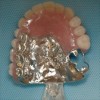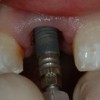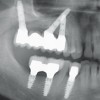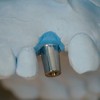After try in of the trial denture, the denture setup must be refined so that minor discrepancies in occlusal plane, centric and bilateral balance etc., are corrected. The purpose of this section is to review the appropriate methods of refining your denture setups prior to processing.
Complete Dentures – Refine Denture Setup — Course Transcript
- 1. 24. Refine Denture SetupThis program of instruction is protected by copyright ©. No portion ofthis program of instruction may be reproduced, recorded or transferredby any means electronic, digital, photographic, mechanical etc., or byany information storage or retrieval system, without prior permission.
- 2. Refining your Denture Setups After try in of the trial denture, the denture setup must be refined so that minor discrepancies in occlusal plane, centric and bilateral balance etc., are corrected. The purpose of this section is to review the appropriate methods of refining your denture setups prior to processing.
- 3. Refining your Denture SetupsPosterior tooth forms Lingualized Monoplane – neutrocentric Monoplane with balancing ramps Lingualized opposing monoplane Semi anatomic (20 degree) Anatomic (30 degree)
- 4. Refining your Denture SetupCheck to see that the marks made previously on the casts indicatingmidline, crest of the ridge, and the retromolar pad are still present. Theselandmarks will be used to refine your denture setup. Maxilla Mandible Midline Ridge Anterior land Retromolar pad
- 5. Lingualized Occlusion
- 6. Refining your Denture Setup Lingualized occlusionPosition the appropriate protrusive insert, and check to ensure that theincisal guide pin is set at zero and in contact with the incisal guide table.
- 7. Lingualized Occlusion Anterior teethThe position of the maxillary anterior teeth wereestablished at try in. Note that the maxillaryanterior teeth follow the curvature of the arch.
- 8. Lingualized Occlusion Anterior teeth• Vertical overlap (1-2 mm)*• Horizontal overlap (1-2 mm)* * The amount of overlap will vary depending on condylar inclination, occlusal plane and esthetics.
- 9. Lingualized OcclusionEnsure that the denture teeth are on plane. The plane of occlusion shouldbe parallel to the body of the mandible and extends from the incisal edges ofthe central incisors and the middle portion of the retromolar pads bilaterally.The appropriate Curve of Spee should be incorporated into the setup.
- 10. Lingualized OcclusionVerify the position of the mandibular denture teeth.• Make sure the posterior mandibular teeth are centered over the ridge
- 11. Lingualized OcclusionVerify centric and make adjustments as necessary. The lingual cusps of themaxillary posterior teeth must rest in the central fossa of the opposing mandibularteeth. There should be no buccal cusp contacts of posterior teeth in centric or inlateral excursion.
- 12. Lingualized Occlusion Check centric from the lingual.
- 13. Lingualized OcclusionVerify working,balancing andprotrusive. Makeadjustments asnecessary. This isthe workingposition.
- 14. Lingualized Occlusion In the anterior region there should be onlylight contact during lateral excursions.
- 15. Lingualized OcclusionVerify working, balancing and protrusive. Make adjustmentsas necessary. This is the balancing position.
- 16. Monoplane Occlusion
- 17. Refining your Denture Setup Monoplane occlusionPosition the appropriate protrusive insert, and check to ensure that theincisal guide pin is set at zero and in contact with the incisal guide table.
- 18. Monoplane Occlusion Anterior teethThe position of the maxillary anterior teeth wereestablished at try in. Note that the maxillaryanterior teeth follow the curvature of the arch.
- 19. Monoplane Occlusion Anterior teeth• Vertical overlap (1-2 mm)*• Horizontal overlap (1-2 mm)* * The amount of overlap will vary depending on condylar inclination, occlusal plane and esthetics. If a neutrocentric concept of occlusion is used no vertical overlap should be incorporated into the set up.
- 20. Refining your Nonanatomic Setup• Verify that all cusp tips except the lateral incisors and sometimes the cuspids, contact the plane of occlusion and check to see that the plane conforms with these landmarks. Make changes as necessary. • Midpoint of the retromolar pads and the edges of the central incisors • Plane should be parallel to the plane of the body of the mandible
- 21. Refining your Nonanatomic Setup Verify that the posterior mandibular teeth are centered over the crest of the ridge. Make corrections as needed.
- 22. Refining your Nonanatomic Setup Check the horizontal overlap of the posterior teeth. Make corrections by moving the maxillary posterior teeth.
- 23. Refining your Nonanatomic Setup Verify again that all the maxillary teeth, with the exception of the lateral incisors and perhaps the cuspids, are on the plane of occlusion. Make corrections by manipulating the maxillary teeth. When you have completed this step, thoroughly cool the wax before proceeding to the next step.
- 24. Refining your Nonanatomic SetupNeutrocentric Reestablish centric contacts by manipulating the mandibular posterior teeth. Make sure that the incisal guide pin contacts the incisal guide table when you have completed this step. While performing this step make sure you do not alter the horizontal overlap. If the neutrocentric concept has been used you are finished. If bilateral balance with balancing ramps is your objective, go on to the next step.
- 25. Refining your Nonanatomic SetupMonoplane with balancing ramps Add the balancing ramp as shown. In all lateral excursions you should observe at least three points of contact bilaterally if bilateral
- 26. Lingualized Opposing Monoplane
- 27. Refining your Denture Setup Lingualized opposing monoplane• Position the appropriate condylar insert, and check to ensure that theincisal guide pin is set at zero and in contact with the incisal guide table.
- 28. Lingualized Opposing Monoplane Anterior teeth The position of the maxillary anterior teeth were established at try in. Note that the maxillary anterior teeth follow the curvature of the arch.
- 29. Lingualized Opposing Monoplane Anterior teeth• Vertical overlap (1-2 mm)*• Horizontal overlap (1-2 mm)* * The amount of overlap will vary depending on condylar inclination, occlusal plane and esthetics. If a neutrocentric concept of occlusion is used no vertical overlap should be incorporated into the set up.
- 30. Lingualized Opposing Monoplane Verify again that all the maxillary teeth, with the exception of the lateral incisors and sometimes the cuspids, are on the plane of occlusion. Make corrections by manipulating the maxillary teeth. When you have completed this step, thoroughly cool the wax before proceeding to the next step.
- 31. Lingualized Opposing MonoplaneVerify that the posterior mandibular teeth are centeredover the crest of the ridge. Make corrections as needed.
- 32. Lingualized Opposing MonoplaneCheck the horizontal overlap of the posterior teeth. Makecorrections by moving the maxillary posterior teeth.
- 33. Lingualized Opposing MonoplaneVerifyagain that all the maxillary teeth, with the exception of the lateral incisorsand sometimes the cuspids, are on the plane of occlusion. Make corrections bymanipulating the maxillary teeth. When you have completed this step,thoroughly cool the wax before proceeding to the next step.
- 34. Lingualized Opposing Monoplane Reestablish centric contacts by manipulating the mandibular posterior teeth. Make sure that the incisal guide pin contacts the incisal guide table when you have completed this step. While performing this step make sure you do not alter the horizontal overlap. If the neutrocentric concept has been used you are finished. If bilateral balance with balancing ramps is your objective, go on to the next step.
- 35. Lingualized Opposing Monoplane Neutrocentric Working Balancing Protrusive In all lateral excursions all posteriors and the incisors maintain contact.
- 36. Lingualized Opposing Monoplane Bilateral balance with balancing ramps Note that the maxillary 2nd molar extends slightly posterior to the mandibular 2nd molar in order that it may engage the balancing ramp during lateral excursion.
- 37. Lingualized Opposing Monoplane Bilateral balance with balancing ramps The balancing ramps are added as shown. In all lateral excursions you should observe at least three points of contact bilaterally to maintain bilateral balance.
- 38. Refining your Denture Setup Semi-anatomicPosition the appropriate protrusive insert, and check to ensure that theincisal guide pin is set at zero and in contact with the incisal guide table.
- 39. Refining your Semi-anatomic Setup Anterior teeth The position of the maxillary anterior teeth were established at try in. Note that the maxillary anterior teeth follow the curvature of the arch.
- 40. Refining your Semi-anatomic Setup Anterior teeth• Vertical overlap (1-2 mm)*• Horizontal overlap (1-2 mm)* * The amount of overlap will vary depending on condylar inclination, occlusal plane and esthetics.
- 41. Refining your Semi-anatomic Setup Verify that the posterior teeth are on plane and the posterior mandibular teeth are centered over the mandibular ridge. For bilateral balance in excursions, the appropriate amount of the Curve of Wilson and the Curve Spee should be incorporated into the setup
- 42. Refining your Semi-anatomic Setup Check buccal and lingual centric.
- 43. Refining your Semi-anatomic Setup Working Balancing Check to ensure you have retained appropriate contacts in working, balancing and protrusive. Protrusive
- 44. Refining your Anatomic Setup
- 45. Refining your Denture Setup Anatomic occlusionPosition the appropriate protrusive insert, and check to ensure that theincisal guide pin is set at zero and in contact with the incisal guide table.
- 46. Refining your Anatomic Setup Anterior teeth The position of the maxillary anterior teeth were established at try in. At this stage only the central incisors need be on the occlusal plane. Note that the maxillary anterior teeth follow the curvature of the arch.
- 47. Refining your Anatomic Setup Anterior teeth• Vertical overlap (1-2 mm)*• Horizontal overlap (1-2 mm)* * The amount of overlap will vary depending on condylar inclination, occlusal plane and esthetics.
- 48. Refining your Anatomic SetupVerify that the posterior teeth are on plane and theposterior teeth centered over the mandibular ridge.
- 49. Refining your Anatomic Setup Check buccal and lingual centric.
- 50. Refining your Anatomic Setup WorkingBalancing Protrusive Check to ensure you have retained appropriate contacts in working, balancing and protrusive.


 Implants and RPDs
Implants and RPDs
 Single Tooth Defects in Posterior Quadrants
Single Tooth Defects in Posterior Quadrants
 Restoration of Posterior Quadrants and Treatment Planning
Restoration of Posterior Quadrants and Treatment Planning
 Cement Retention vs Screw Retention
Cement Retention vs Screw Retention
